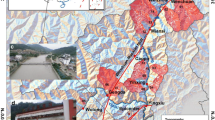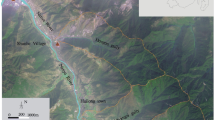Abstract
The Wenchuan earthquake of May 12, 2008 produced large amounts of loose material (landslide debris) that are still present on the steep slopes and in the gullies. This loose material creates an important hazard as strong rainfall can cause the development of devastating debris flows that will endanger the resettled population and destroy the result of reconstruction efforts. On 14 August 2010, a total of 21 debris flows were triggered by heavy rainfall around the town of Yingxue, located near the epicenter of the Wenchuan earthquake. One of these debris flows produced a debris dam, which then changed the course of the river and resulted in the flooding of the newly reconstructed Yinxue town. Prior to this catastrophic event, debris flow hazard had been recognized in the region, but its potential for such widespread and devastating impacts was not fully appreciated. Our primary objective for this study was to analyze the characteristics of the triggering rainfall and the sediment supply conditions leading to this event. Our field observations show that even small debris flow catchment areas have caused widespread sediment deposition on the existing fans. It is concluded that the whole of the area shaken by the Wenchuan earthquake is more susceptible to debris flows, initiated by localized heavy rainfall, than had been assumed earlier. The results of this study contribute to a better understanding of the conditions leading to catastrophic debris flow events in the earthquake-hit area. This is essential for the implementation of proper early warning, prevention, and mitigation measures as well as a better land use planning in this area.












Similar content being viewed by others
References
Alexander D (1989) Urban landslides. Prog Phys Geogr 13:157–191
Bovis MJ, Jakob M (1999) The role of debris supply conditions in predicting debris flow activity. Earth Surf Process Land 24:1039–1054
Burchfiel BC, Chen Z, Liu Y, Royden LH (1995) Tectonics of the Longmen Shan and adjacent regions. Int Geol Rev 37:661–735
Caine N (1980) The rainfall intensity–duration control of shallow landslides and debris flows. Geogr Ann 62A:23–27
Campbell RH (1975) Soil slips, debris flows and rainstorms in the Santa Monica Mountains and vicinity. Southern California, US Geological Survey Professional paper vol.851, US Geological Survey, Washington, DC
Campbell RH, Fleming RW, Prior DB, Nichols DJ, Hampton MA, Sangrey DA, Brabb EE (1989) Landslide classification for identification of mud flows and other landslides. In: Sadler PM, Morton DM (eds) Landslides in a semiarid environment, Publications of the Inland Geological Society, 2nd edn. University of California, California, pp 1–27
Cannon SH, Kirkham RM, Parise M (2001) Wildfire-related debris flow initiation processes, Storm King Mountain, Colorado. Geomorphology 39:171–188
Cepeda J, Høeg K, Nadim F (2010) Landslide-triggering rainfall thresholds: a conceptual framework. Q J Eng Geol Hydrogeol 43:69–84
Chen CY (2009) Sedimentary impacts from landslides in the Tachia River Basin. Geomorphology 105:355–365
Chen H, Petley DN (2005) The impact of landslides and debris flows triggered by Typhoon Mindulle in Taiwan. Q J Eng Geol Hydrogeol 38:301–304
Chen H, Dadson S, Chi YG (2006) Recent rainfall-induced landslides and debris flow in northern Taiwan. Geomorphology 77:112–125
Cojean R (1994) Role of groundwater as a triggering factor for landslides and debris flow, Proc Int Workshop on flood and inondations related to large earth movements, Trento, Italy A13:1–19
Costa JE (1984) Physical geomorphology of debris flows. In: Costa JE, Fleisher PJ (eds) Chapter 9 of development and application of geomorphology. Springer, New York, pp 268–371
Crosta G (1998) Regionalization of rainfall thresholds: an aid to landslide hazard evaluation. Environ Geol 35:131–145
Dadson SJ, Hovius N, Chen H, Dade WB, Lin JC, Hsu ML, Lin CW, Horng MJ, Chen TC, Milliman J, Stark CP (2004) Earthquake-triggered increase in sediment delivery from an active mountain belt. Geology 32:733–736
Dai F, Lee CF, Wang S (1999) Analysis of rainstorm-induced slide-debris flows on natural terrain of Lantau Island, Hong Kong. Eng Geol 51:279–290
Dai FC, Xu C, Yao X, Xu L, Tu XB, Gong QM (2010) Spatial distribution of landslides triggered by the 2008 Ms 8.0 Wenchuan earthquake, China. J Asian Earth Sci. doi:10.1016/j.jseaes.2010.04.010
Dong JJ, Lee CT, Tung YH, Liu CN, Lin KP, Lee JJ (2009) The role of the sediment budget in understanding debris flow susceptibility. Earth Surf Process Landforms 34:1612–1624
Fleming RW, Ellen SD, Algus MA (1989) Transformation of dilative and contractive landslide debris into debris flows an example from Marin County, California. Eng Geol 27:201–223
Guzzetti F, Cardinali M, Reichenbach P, Cipolla F, Sebastian C, Galli M, Salvati P (2004) Landslides triggered by the 23 November 2000 rainfall event in the Imperia Province, Western Liguria, Italy. Eng Geol 73:229–245
Guzzetti F, Ardizzone F, Cardinali M, Rossi M, Valigi D (2009) Landslide volumes and landslide mobilization rates in Umbria, central Italy. Earth Planet Sci Lett 279:222–229
Huang RQ, Li WL (2009) Analysis of the geo-hazards triggered by the 12 May 2008 Wenchuan Earthquake, China. Bull Eng Geol Environ 68:363–371
Hürlimann M, Copons R, Altimir J (2006) Detailed debris flow hazard assessment in Andorra, a multidisciplinary approach. Geomorphology 78:359–372
Iverson RM (1997) The physics of debris flows. Rev Geophys 35:245–296
Iverson RM (2000) Landslide triggering by rain infiltration. Water Resour Res 36:1897–1910
Jakob M, Bovis M, Oden M (2005) The significance of channel recharge rates for estimating debris-flow magnitude and frequency. Earth Surf Process Land 30:755–766
Jan CD, Chen CL (2005) Debris flows caused by typhoon herb in Taiwan. In: Jakob M, Hungr O (eds) Debris flow hazards and related phenomena. Springer, Berlin, pp 363–385
Jibson RW (1989) Debris flow in southern Porto Rico. In: Schultz AP, Jibson RW (eds) Landslide Processes of the Eastern United States and Puerto Rico. Geological Society of America Special Paper, 236th edn., pp 29–55
Koi T, Hotta N, Ishigaki I, Matuzaki N, Uchiyama I, Suzuki M (2008) Prolonged impact of earthquake-induced landslides on sediment yield in a mountain watershed, The Tanzawa region, Japan. Geomorphology 101:692–702
Li H, Fu X, van der Woerd J, Si J, Wang Z, Hou L, Qiu Z, Li N, Wu F, Xu Z, Tapponnier P (2008) Co-seisimic surface rupture and dextral-slip oblique thrusting of the Ms 8. 0 Wenchuan earthquake. Acta Geol Sin 82(12):1623–1643
Lin CW, Shieh CL, Yuan BD (2003) Impact of Chi-Chi earthquake on the occurrence of landslides and debris flows: example from the Chenyulan River watershed, Nantou, Taiwan. Eng Geol 71:49–61
Lin CW, Liu SH, Lee SY, Liu CC (2006) Impacts on the Chi-Chi earthquake on subsequent rain-induced landslides in central Taiwan. Eng Geol 86:87–101
Lin GW, Chen H, Chen YH, Horng MJ (2008) Influence of typhoons and earthquakes on rainfall-induced landslides and suspended sediments discharge. Eng Geol 97:32–41
Liu XL, Wang QC, Kong JM, He SM, Su PC (2004) Hazard assessment of debris flows and their developing trend along Dujiangyan–Wenchuan highway. J Disast Prevent Mitigat Eng 24:41–46, in Chinese
Liu CN, Huang HF, Dong JJ (2008) Impacts of September 21, 1999 Chi-Chi earthquake on the characteristics of gully-type debris flows in central Taiwan. Nat Hazards 4:349–368
Marchi L, D Agostino V (2004) Estimation of debris flow magnitude in the eastern Italian Alps. Earth Surf Process Land 29:207–220
Marchi L, Arattano M, Deganutti AM (2002) Ten years of debrisflow monitoring in the Moscardo, Torrent Italian Alps. Geomorphology 46:1–17
Martin Y, Rood K, Schwab JW, Church M (2002) Sediment transfer by shallow landsliding in the Queen Charlotte Islands, British Columbia. Can J earth Sci 39:189–205
Montgomery DR, Schmidt KM, Greenberg HM, Dietrich WE (2000) Forest clearing and regional landsliding. Geology 28:311–314
Prochaska AB, Santia PM, Higgins JD, Cannon SH (2008) Debris-flow runout predictions based on the average channel slope (ACS). Eng Geol 98:29–40
Qi SW, Xu Q, Lan HX, Zhang B, Liu JY (2009) Spatial distribution analysis of landslides triggered by 2008. 5.12 Wenchuan Earthquake, China. Eng Geol. doi:10.1016/j.enggeo.2010.07.011
Reid ME, Nielsen HP, Dreiss SJ (1988) Hydrologic factors triggering a shallow hillslope failure. Bull Assoc Eng Geol 25:349–361
Schuerch P, Densmore AL, McArdell BW, Molnar P (2006) The influence of landsliding on sediment supply and channel change in a steep mountain catchment. Geomorphology 78:222–235
Shieh CL, Chen YS, Tsai YJ, Wu JH (2009) Variability in rainfall threshold for debris flow after the Chi-Chi earthquake in central Taiwan, China. Int J Sediment Res 24:177–188
Stoffel M (2010) Magnitude–frequency relationships of debris-flows—a case study based on field surveys and tree-ring records. Geomorphology 116:67–76
Takahashi T (1981) Estimation of potential debris flows and their hazardous zones. J Nat Disaster Sci 3:57–89
Tan WP, Hen QY (1992) Study on regional critical rainfall induced debris flow in Sichuan Province. Journal of Catastrophology 7:37–42 (in Chinese)
Tang C, Zhu J, Li WL (2009) Rainfall triggered debris flows after Wenchuan earthquake. Bull Int Assoc Eng Geol 68:187–194
Varnes DJ (1978) Slope movement types and processes. In: Schuster RL, Krizek RJ (eds) Landslides analysis and control. Transportation research board special report, vol, 176. National Research Council, Washington, DC, pp 11–33
Wieczorek GF (1987) Effect of rainfall intensity and duration on debris flows in central Santa Cruz Mountains, California. In: Costa JE, Wieczorek GF (eds) Debris flows/avalanches, process, recognition and mitigation, Geological Society of America, Reviews in Engineering Geology, 7th edn., pp 93–104
Yin YP, Wang FW, Sun P (2009) Landslide hazards triggered by the 2008 Wenchuan earthquake, Sichuan, China. Landslides 6:139–152
Zhai PM, Zhang XB, Wan H, Pan XH (2005) Trends in total precipitation and frequency of daily precipitation extremes over China. J Climate 18:1096–1108
Zhang JS, Xie H (2008) Study on factors affecting the river-blocking due to debris flows in the upper reaches of Minjiang River. Resources and Environment in the Yangtze Basin 17:651–655 (in Chinese)
Acknowledgments
This work was supported by the 973 program (no. 2011CB409903), Program of Changjiang Scholars and Innovative Research Team in University (no. IRT0812), and Research Fund of the State Key Laboratory of Geo-Hazard Prevention (no. SKLGP2009Z004). We express our gratitude to Prof. Niek Rengers (ITC) for his comments and suggestions on earlier versions of the manuscript.
Author information
Authors and Affiliations
Corresponding author
Rights and permissions
About this article
Cite this article
Tang, C., Zhu, J., Ding, J. et al. Catastrophic debris flows triggered by a 14 August 2010 rainfall at the epicenter of the Wenchuan earthquake. Landslides 8, 485–497 (2011). https://doi.org/10.1007/s10346-011-0269-5
Received:
Accepted:
Published:
Issue Date:
DOI: https://doi.org/10.1007/s10346-011-0269-5




